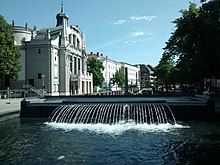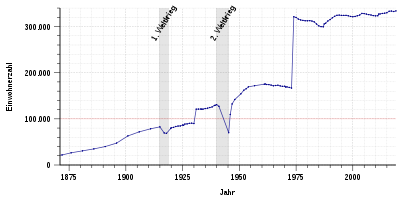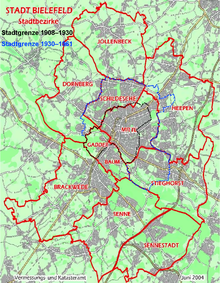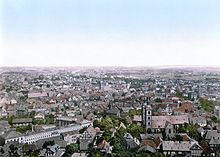Bielefeld
![]()
This article is about the city in North Rhine-Westphalia. For other meanings, see Bielefeld (disambiguation).
Bielefeld [![]()
![]() ˈbiːləfɛlt] (East Westphalian Builefeld, Bielefeld, Beilefeld or Builefeild) is an independent large city in the administrative district of Detmold in the northeast of North Rhine-Westphalia. With over 334,000 inhabitants, it is the largest city in the region of East Westphalia-Lippe and its economic centre. Bielefeld is the eighth largest city in North Rhine-Westphalia. In state planning, Bielefeld is classified as a regional centre. On the list of large cities in Germany, it ranks 18th in terms of population and 11th in terms of area.
ˈbiːləfɛlt] (East Westphalian Builefeld, Bielefeld, Beilefeld or Builefeild) is an independent large city in the administrative district of Detmold in the northeast of North Rhine-Westphalia. With over 334,000 inhabitants, it is the largest city in the region of East Westphalia-Lippe and its economic centre. Bielefeld is the eighth largest city in North Rhine-Westphalia. In state planning, Bielefeld is classified as a regional centre. On the list of large cities in Germany, it ranks 18th in terms of population and 11th in terms of area.
The first mention can be dated to the beginning of the 9th century, and it was first referred to as a town in 1214. Located at the northern end of a transverse valley of the Teutoburg Forest, the merchant town was intended to promote trade in the county of Ravensberg, of which it became the largest town. For a long time Bielefeld was the centre of the linen industry. Today the city is primarily home to the food industry, trading and service companies, the printing and clothing industry and mechanical engineering. Its university, the v. Bodelschwinghschen Stiftungen Bethel, the Dr. August Oetker KG and the Bundesliga club Arminia Bielefeld are known nationwide.

Sparrenburg and view of the city centre

Niederwall with a view of the municipal theatre
History
→ Main article: History of the city of Bielefeld
In 2017, remains of a presumably 2000-year-old Roman military camp were discovered in a wooded area of Bielefeld-Sennestadt.
→ Main article: Roman camp Bielefeld
Furthermore, a ring wall was discovered in 1988, which suggests a Roman construction site around 32/31 BC.
→ Main article: Roman circular ditch complex on the Sparrenberg harrow
The place was mentioned as early as the middle of the 9th century, when a mansus in Bylanuelde was transferred to the Corvey monastery. The first mention of the town of Bielefeld dates back to 1214. Bielefeld was one of the numerous town foundations of the High Middle Ages and came into being with the intention of securing the sovereign's rule, as it was located on the southern border of the county of Ravensberg. The sovereigns wanted to develop the town as a merchant town and capital of the county.
Due to its location at the crossroads of several ancient trade routes and at an important pass through the Teutoburg Forest, Bielefeld quickly developed into the economic and financial centre of the county of Ravensberg. Around 1240, construction began on Sparrenburg Castle, which, once completed, served as the residence of the lord of the county and his retinue. The castle was also intended to protect the town and the pass over the mountains of the Teutoburg Forest. From 1293 the new town was built. The inhabitants, mainly merchants and craftsmen, grew prosperous, not least because they joined the Hanseatic League in the 15th century.
In the run-up to and in the course of the Thirty Years' War (1618-1648), the Sparrenburg was occupied successively by Dutch, Spanish, Swedish and French troops. In 1636 and 1637 the plague raged in Bielefeld and claimed about 350 victims. In the 17th century, Bielefeld began to develop into a "linen town", which at that time mainly meant the linen trade. The farmers of the Ravensberg region preferred to grow state-subsidised flax on their farmland instead of corn and processed it into linen in home industries. The linen trade led to a certain prosperity in the city. Around 1830 the Bielefeld linen trade fell into a serious crisis, as machine-woven fabrics began to be produced in Ireland, England and Belgium. The economic hardship of many Bielefelders led to unrest during the revolution of 1848. In addition, many people left their homes in East Westphalia and emigrated to America.
Around 1860 tobacco production developed in the Ravensberg countryside. The tobacco factory Gebr. Crüwell in Bielefeld, one of the most important of its kind in Germany, subcontracted certain work to home production, so that the rural population found new sources of income. When the connection to the Cöln-Minden railway was completed in 1847, factories soon developed. With the Ravensberg spinning mill, a company was founded that developed into the largest flax spinning mill in Europe. By 1870 Bielefeld was already the centre of the textile industry in Germany.
In 1867, the Von Bodelschwingh'sche Anstalten Bethel were founded in today's Gadderbaum district. Mechanical engineering developed alongside the textile industry. Today, Bielefeld is the fifth largest mechanical engineering location in Germany. At the end of the 19th century, the food industry became important for Bielefeld. With the Oetker Group, the city is home to one of the largest representatives of this industry in Europe.
In 1938, around 900 citizens of Jewish faith lived in Bielefeld. The Jewish community had a magnificent synagogue in Turnerstraße, which was inaugurated in 1905. It was looted and burned down by the National Socialists on the night of November 9-10, 1938, during the Night of Pogroms. Shortly afterwards, on 12 November 1938, 406 men from Bielefeld and East Westphalia-Lippe were deported to Buchenwald. In the autumn of 1939 the Jewish people in Bielefeld were deprived of their right to their own living space and were assigned to so-called Jewish houses. A forced labour camp was set up in the Schlosshof. In the period that followed, Jewish people were deprived of more and more rights. On 13 December 1941, the first of a total of eight further deportations followed. For most of the deportees they meant death. So far, 1604 people of Jewish origin have been identified who were deported from Bielefeld between 1941 and 1945. The total number of Holocaust victims is significantly higher.
The heaviest air raid on the city during the Second World War took place on 30 September 1944, killing 649 people and destroying most of the old town and many historic buildings. On April 4, 1945, the "fortress" of Bielefeld was taken by American troops. This was preceded by two days of heavy fighting in the wooded areas south of the city. Thanks to the courage of some Bielefeld citizens, further bloodshed was prevented during the advance of the American troops. The mayor of Brackwede, Hermann Bitter, opened the tank traps to the Americans on April 3, 1945, and was then shot by the NSDAP district leader. As the American units advanced toward the city center on April 4, 1945, the Protestant pastor Karl Pawlowski rode his bicycle along the battle-ready German defenses and persuaded the soldiers to withdraw. Bielefeld was then taken without resistance. When the first American jeeps drove through Bielefeld, a white flag was already flying from the town hall. During the war more than 1300 people were killed by bombs in Bielefeld.
Destroyed historical buildings were replaced by modern buildings after the war. Industry was rebuilt within a few years and the economic boom began. However, the textile industry became less and less important, while the city developed into a service centre.
A special urban development feature of the post-war period is the planned town of Sennestadt.
Bielefeld University was founded in 1969.
Incorporations
See also: History of the Bielefeld district
In 1828, the Niedermühlen estate was incorporated into the field marker of the city of Bielefeld. On April 1, 1900, parts of the municipality of Gadderbaum and the Sparrenburg area were incorporated into Bielefeld. On 31 January 1907, parts of the municipality of Quelle as well as the Meyer zu Olderdissen farm and the Schildhof farm followed. On 1 October 1930, the municipalities of Schildesche Dorf, Sieker and Stieghorst as well as parts of the municipalities of Gellershagen, Großdornberg, Heepen, Hoberge-Uerentrup, Oldentrup, Schildesche Bauerschaft and Theesen were transferred from the district of Bielefeld to the city of Bielefeld. 54 ha of the municipality of Babenhausen were added on 31 December 1961 and 56 ha of the municipality of Brake on 1 January 1965.
The most extensive territorial reform to date, regulated in the law on the reorganisation of the Bielefeld area, came into force on 1 January 1973. The towns of Brackwede and Sennestadt as well as the communities of Gadderbaum, Senne I, Babenhausen, Großdornberg, Hoberge-Uerentrup, Kirchdornberg, Niederdornberg-Deppendorf, Altenhagen, Brake, Brönninghausen, Heepen, Hillegossen, Lämershagen-Gräfinghagen, Milse, Oldentrup, Ubbedissen, Jöllenbeck, Theesen and Vilsendorf were transferred from the district of Bielefeld to Bielefeld.) the municipality of Schröttinghausen. The district of Bielefeld was dissolved.
Population development
→ Main article: Population development of Bielefeld
Around the year 1800, Bielefeld had about 5,500 inhabitants. Due to industrialization, this number rose steadily in the following decades and was over 60,000 inhabitants in 1900. In 1930, Bielefeld's population exceeded 100,000 within the boundaries of the time, making the city a metropolis. In the post-war period, the population had risen to over 175,000 by 1961, about 60,000 of whom had come to Bielefeld as refugees and displaced persons after the Second World War. After a slight decline until 1972, the population grew to more than 320,000 in 1973 due to the incorporation of almost all the towns belonging to the district of Bielefeld, including Brackwede with 39,856, Sennestadt with 20,187 and Senne I with 17,421 inhabitants (population figures from 1970). With 321,200 inhabitants at the end of 1973, an interim peak was reached which has only been permanently surpassed since 1991. Bielefeld ranks 18th among large German cities and eighth in North Rhine-Westphalia.

Population development of Bielefeld from 1871 to 2018

Development of the urban area since the beginning of the 20th century

New City Hall

Bielefeld around 1895

Old city hall
Politics
Local politics
See also: History of the city leaders of Bielefeld and results of the local elections in Bielefeld
City Council Election 2020
as a percentage
%
30
20
10
0
27,75
24,94
22,32
7,05
6,12
3,43
2,91
1,60
1,23
2,65
CDU
SPD
Green
FDP
Left
AfD
PARTEI
BfB
WGBN
Otherwise.
gains and losses
compared to 2014
%p
8
6
4
2
0
-2
-4
-6
-8
−2,45
−5,86
+6,42
+4,15
−1,18
+3,43
+2,91
−6,90
+0,33
+2,65
CDU
SPD
Green
FDP
Left
AfD
PARTEI
BfB
WGBN
Otherwise.
Template:Election Chart/Maintenance/Old Result Not 100%
Template:Election Chart/Maintenance/Color Input Error - Dark
In 1994, the dual leadership in the city administration was abandoned in Bielefeld. Since then, there has only been a full-time Lord Mayor. He is the highest representative of the city, chairman of the council and head of the city administration. He has been directly elected by the electorate since 1999. Pit Clausen of the SPD has held the office since 2009. He was last confirmed as Lord Mayor on 27 September 2020 in a run-off election with 56.09 percent of the valid votes, while his challenger Ralf Nettelstroth (CDU) received 43.91%. The voter turnout was 40.69%. In his representative function he is represented by the honorary mayors Andreas Rüther (CDU), Karin Schrader (SPD) and Christina Osei (Greens). In his function as head of administration, he is represented by the alderman Moss (CDU).
Including the Lord Mayor, who has one vote ex officio, the Bielefeld City Council has 67 members in the new election period. The debts of the City of Bielefeld, its own undertakings and its shareholdings amounted to 1.639 billion euros at the end of 2012. That is 5004 euros per inhabitant.
In March 2021, the SPD, BÜNDNIS 90/DIE GRÜNEN and the LINKE agreed to form a coalition for the current legislative period.
| Results of local elections in Bielefeld since 1975 | ||||||||||||||||||||
| 2020 | 2014 | 2009 | 2004 | 1999 | 1994 | 1989 | 1984 | 1979 | 1975 | |||||||||||
| Party | Seats | % | Seats | % | Seats | % | Seats | % | Seats | % | Seats | % | Seats | % | Seats | % | Seats | % | Seats | % |
| SPD | 16 | 24,94 | 20 | 30,8 | 20 | 30,3 | 19 | 31,43 | 22 | 31,32 | 28 | 41,31 | 27 | 38,99 | 28 | 41,27 | 31 | 45,81 | 32 | 46,53 |
| CDU | 18 | 27,75 | 20 | 30,2 | 22 | 33,2 | 22 | 36,78 | 32 | 45,72 | 24 | 36,24 | 24 | 34,56 | 27 | 39,43 | 28 | 41,61 | 30 | 43,90 |
| Green1 | 15 | 22,32 | 11 | 15,9 | 11 | 17,2 | 9 | 15,46 | 8 | 10,60 | 8 | 12,48 | 6 | 10,05 | 9 | 13,5 | 4 | 5,6 | - – | - – |
| BfB | 1 | 1,6 | 6 | 8,5 | 3 | 5,2 | 4 | 6,36 | 4 | 6,29 | 5 | 7,44 | 6 | 9,6 | - – | - – | - – | - – | - – | - – |
| The Left | 4 | 6,12 | 5 | 7,3 | 4 | 5,7 | 2 | 2,70 | 2 | 2,81 | - – | - – | - – | - – | - – | - – | - – | - – | - – | - – |
| FDP | 5 | 7,05 | 2 | 2,9 | 4 | 5,6 | 2 | 4,34 | 2 | 3,26 | 0 | 2,54 | 4 | 6,54 | 3 | 5,43 | 4 | 6,54 | 5 | 8,68 |
| Pirates | 1 | 1,233 | 1 | 2,2 | - – | - – | - – | - – | - – | - – | - – | - – | - – | - – | - – | - – | - – | - – | - – | - – |
| Proximity | 1 | 0,9 | 2 | 2,7 | 2 | 2,93 | - – | - – | - – | - – | - – | - – | - – | - – | - – | - – | - – | - – | ||
| AfD | 2 | 3,43 | - – | - – | - – | - – | - – | - – | - – | - – | - – | - – | - – | - – | - – | - – | - – | - – | - – | - – |
| The PARTY | 2 | 2,91 | - – | - – | - – | - – | - – | - – | - – | - – | - – | - – | - – | - – | - – | - – | - – | - – | - – | - – |
| BIG | 1 | 0,99 | - – | - – | - – | - – | - – | - – | - – | - – | - – | - – | - – | - – | - – | - – | - – | - – | - – | - – |
| LiB | 1 | 0,95 | - – | - – | - – | - – | - – | - – | - – | - – | - – | - – | - – | - – | - – | - – | - – | - – | - – | - – |
| Other | - – | 0,71 | - – | 1,3 | - – | - – | - – | - – | - – | - – | - – | - – | - – | -,2 | - – | 0,4 | - – | 0,5 | - – | 0,89 |
| Total2 | 66 | 100 | 66 | 100 | 66 | 100 | 60 | 100 | 70 | 100 | 65 | 100 | 67 | 100 | 67 | 100 | 67 | 100 | 67 | - |
| Voter turnout | 53,57 | 51,0 | 52,9 | 53,81 | 57,93 | 82,83 | 66,72 | 67,68 | 69,68 | 86,44 | ||||||||||
1 1979 and 1984 Bunte Liste, local forerunner organisation of the Green Party
2 without taking rounding errors into account
3 Joint list of Citizens' Rights and Pirate Party
Coat of arms

Logo: The town's coat of arms shows a silver shield with three red chevrons in a golden field under a red, crenellated and open wall arch with two masonry towers.
In its basic form, this coat of arms has existed since 1263; at that time it was considered the coat of arms of the old town. When the old town was united with the new town in 1520, the coat of arms became the official coat of arms of the now united town. This did not change until the 19th century, but then lions within coats of arms became more and more fashionable, so that from then on the coat of arms was carried by two lions. Since 1973 the coat of arms in shield form and without lions is the official coat of arms of the city of Bielefeld. The shield with the chevrons corresponds to the arms of the county of Ravensberg, of which Bielefeld was once the capital. The towers show an outer part of the outer wall.
Twinning
During a visit by education experts from Rochdale in England to trade union representatives in Bielefeld, those involved came up with the idea of a town twinning, which was entered into in 1953. As symbols of the partnership, a bridge in Rochdale and the park in front of the Ravensberger Spinnerei in Bielefeld are named after the respective twin town. There is also an English telephone box at the Nicolai Church in Bielefeld.
The borough of Brackwede has been twinned with Enniskillen in Northern Ireland since 1958. The starting point of the partnership was the appearance of the Royal Enniskilling Dragoon Guards at the Brackwede Rifle Festival in 1957. As a sign of the friendship, a street in Brackwede was named after the twin town. Regular student exchanges between Brackwede Grammar School and Portora Royal School are part of the twinning programme.
The folklore group Cercle Celtic from Concarneau in France gave a performance in the then still independent municipality of Senne in 1967. In 1973, the friendships formed developed into a firm partnership with today's borough. Today, streets in the towns are named after the respective twin town.
Gerhard Hoepner from Bielefeld maintained private contact with Andreas Meyer, who had emigrated to Nahariya in Israel. This developed into a town twinning in 1980. Today there is a window between the two town halls in Bielefeld and a street named after the twin city. In Nahariya a church from the 6th century could be restored with donations from Bielefeld. Therefore it is called Bielefeld church today. The Gymnasium Heepen and the Amalschule in Nahariya also maintain a partnership.
As a result of a decision by the Bundestag on military rearmament in the winter of 1983/84, Bielefeld established contact with the Russian city of Veliky Novgorod. The correspondence developed into a town twinning, which was entered into in 1987. A street in the new railway station district and an oak tree at the Sparrenburg were named after the twin city. In the 1990s, many aid transports were undertaken to the Russian twin town. Even today, social projects in Veliky Novgorod receive financial support. Schools and universities regularly exchange information.
The German-Polish Society in Bielefeld initiated a partnership with the Polish city of Rzeszów in 1991. Schools and universities in the cities exchange information on a regular basis.
Since 1984, Bielefeld has maintained contacts with Estelí in Nicaragua, which were expanded into a permanent twinning arrangement in 1995. The city was devastated by a hurricane in 1998 and was rebuilt with the help of donations from Bielefeld and other twin towns. The partnership is supported by the Bielefeld schools, which carry out joint projects with the schools in Estelí. After reports from Welthaus Bielefeld indicated that snipers shot at demonstrators from the roof of the city hall in Estelí in April 2018, probably with the knowledge of the mayor, the Bielefeld city administration put the partnership with Estelí on hold for the time being. The civil society projects, however, continue.
Bielefeld has taken on sponsorships for the former East German towns of Gumbinnen/East Prussia (Gussew, Kaliningrad Oblast, Russia), Wansen/Silesia (Wiązów, Poland) and Münsterberg/Silesia (Ziębice, Poland). After the Second World War, Bielefeld helped the displaced inhabitants of these towns with their social and economic integration.
Federal Politics
Bielefeld is located in the Bundestag constituency 132 Bielefeld - Gütersloh II. In the 2017 Bundestag election, Wiebke Esdar (SPD) won the direct mandate. Britta Haßelmann (Bündnis 90/Die Grünen) and Friedrich Straetmanns (DIE LINKE) also entered the Bundestag from Bielefeld via the state lists of their parties.
Country policy
In elections to the state parliament of North Rhine-Westphalia, the municipal districts of Mitte, Schildesche and Gadderbaum form constituency 92 Bielefeld I and the municipal districts of Heepen, Brackwede, Stieghorst, Sennestadt and Senne form constituency 93 Bielefeld II. The municipalities of Dornberg and Jöllenbeck, together with Borgholzhausen, Halle, Steinhagen, Versmold and Werther, belong to constituency 94 Gütersloh I - Bielefeld III. The direct mandates in the 2010 state election were won by Christina Kampmann (SPD) in constituency 92, Regina Kopp-Herr (SPD) in constituency 93 and Georg Fortmeier (SPD) in constituency 94. In addition, Matthias Bolte (Greens) entered the state parliament from Bielefeld via his party's state list.
Search within the encyclopedia